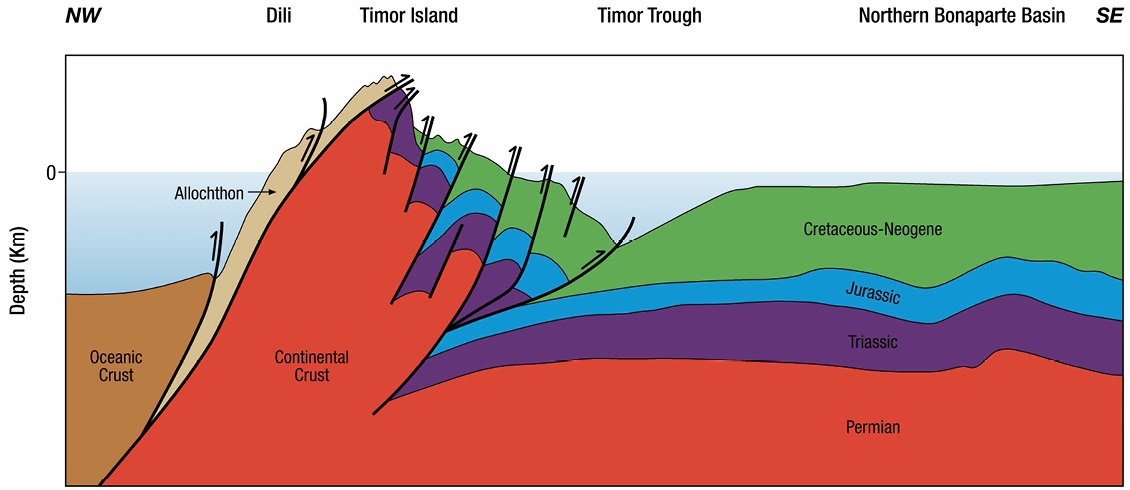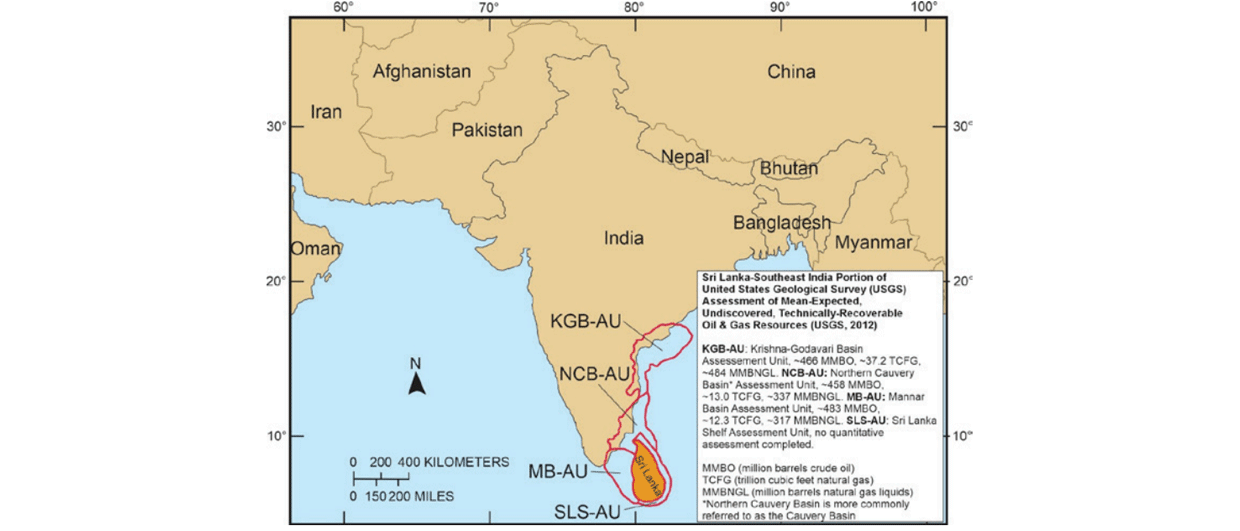Timor-Leste: Exploration Renaissance
The island of Timor-Leste between Indonesia and Australia is the subject of some intense scrutiny these days, delivering opportunities for an oil and gas industry focused on low-risk and fast returns. The regulatory authority Autoridade Nacional do Petróleo e Minerais (ANPM) is currently promoting a major bid round for new acreage. Several offshore discoveries are moving closer to development, notably large gas reserves at Greater Sunrise and Chuditch, while conventional oil fields in the western offshore area are being targeted for redevelopment, including Buffalo, with several other oil accumulations ready to be developed or redeveloped. The local firm Timor Resources and national oil company Timor Gap have just commenced a three-well drilling campaign onshore, raising interest in a long-neglected oil play on the coast.
Timor-Leste and its offshore extension represent an interesting structural margin with proven hydrocarbons either side of the Timor Thrust. Running along the coastal area north-east to south-west, this major thrust, part of the eastern Banda Arc, divides the region into a large accretionary prism to the north, with Palaeocene to recent deformed sediments of the Viqueque Basin sitting on top of the remnant Triassic to Cretaceous platform, now thrusted to the south.
Imaging is poor in this upper prism and almost impossible below, but small fields have been proven through both plays (e.g., Macia). South of the thrust, the Australian Foreland Basin stretches from the Timor Trough to the North West Shelf of Australia, dipping gently upwards to the south east and creating major anticline and fault-bound gas plays (Greater Sunrise, Bayu-Undan, Chuditch) and smaller faulted oil plays to the west (Kitan, Buffalo). Here seismic imaging is much improved, and the major fluvio-deltaic sandstone of the Jurassic Plover Formation can be mapped across the offshore region, with secondary plays in the Mesozoic. The great majority of reserves so far have been found south of the major thrust belt, partly due to better imaging, and also a simpler source-migration-trap geometry.
ANPM are currently running an open bid round, with ample acreage across seven onshore blocks (A to G) and 11 offshore blocks (H to R). Large amounts of seismic and well data are available, with data packages from EZ Data Room and Searcher Seismic. This is the third bid round in Timor-Leste and they have a reasonably good track record; in 2003 the first round resulted in the Bayu-Undan discovery, and the second round in 2006 led to the discovery and subsequent production from the Kitan field (Eni). Since 2019 the entire offshore area has moved into Timor-Leste jurisdiction, with the original Joint Petroleum Development Area (JPDA) being abandoned, resulting in simpler taxing and regulation (Greater Sunrise retains a small tax split for the Australians, once developed). This has clearly improved the level of interest in both the current bid round and the investment climate here for future field developments. The current licensing regime utilises the production sharing contract (PSC) model, and terms are comparably favourable for this region, with no signature bonus, a high oil and gas cost split and a healthy 60% contractor split on profit for oil and gas. Companies are obliged to prequalify, with the current prequal deadline set for 14 January 2022. Bids are expected by 4 March 2022. Timor Gap, the state entity, should participate at 20% in each PSC.
Several significant hydrocarbon projects remain to be developed offshore. The Kitan field was shut by Eni in 2015 due to low oil prices, as was Buffalo several years previously by Nexen. Carnarvon and partner Advance Energy are about to spud Buffalo-10 to test the attic oil volumes at Buffalo, with a field development programme in place for 2022 if drilling is successful. The 3.4 Tcf plus 400 MMbbl condensate Bayu-Undan wet gas field previously operated by ConocoPhillips now resides with Santos and partners INPEX and SK, providing gas feedstock for the Darwin LNG 500 km away in NW Australia. A three-well redevelopment programme is nearing completion with the first well flowing an impressive 178 MMcfgd plus 11,350 bcpd. Santos has now reached financial investment decision (FID) on the Barossa gas development in the North West Shelf (Australia), and the Australian firm is seeking to achieve carbon-neutral gas and LNG facilities across its portfolio. This could include carbon capture and storage (CCS) at Bayu-Undan, an exciting development for Timor-Leste.
To the east, the large gas reserves at Greater Sunrise and Chuditch are also the subject of appraisal and development planning. Woodside are working towards FID on the Greater Sunrise gas field, which would either export gas to the Liquefied Natural Gas (LNG) projects on the North West Shelf, or could involve a pipeline to Timor-Leste for liquefaction, bolstering their LNG prospects in the region. Woodside are also heavily engaged in planning for a carbon-neutral footprint across their LNG portfolio. The UK firm Baron Oil is finalising a major 3D reprocessing project over the 3.4 Tcf Chuditch gas discovery complex to the south, whereby the firm will be looking to firm up an appraisal drilling campaign. With several development scenarios available, LNG backfill is expected to feature heavily.
Onshore, the Timor-Leste firm Timor Resources, in partnership with Timor Gap, are ending a 50-year hiatus for onshore exploration drilling, having recently spud the first of three wells. The Feto Kmaus well will target multiple potential reservoirs from the Jurassic to Triassic, including the Plover Sandstone Group. The chance of success is considered reasonably high, with the Triassic Aitutu Formation underpinning many source kitchens onshore. A third well, Rusa-1, may also test the sub-thrust play deeper into the Triassic and older.
Given the number of existing and planned developments in Timor-Leste, the strong relationship between large offshore gas reserves and LNG in the region, and a broad licensing round with good terms and favourable geology, there is no doubt Timor-Leste will figure strongly in the regional hydrocarbon dynamics going forward. With net carbon targets being pursued by the regional majors, and CCS technology actively being considered, this island nation will find itself literally at the crossroads of the future oil and gas landscape between South East Asia and Australasia. Domestic growth and local content development are set to benefit in parallel, with an exciting onshore drilling campaign kicked off, and future infrastructure opportunities for the island.
Further Reading
GEO ExPro articles relating to oil and gas exploration in Timor-Leste:
New Technology Supports Oil and Gas Exploration in Timor-Leste
GEO ExPro
The Autoridade Nacional do Petróleo e Minerais Timor-Leste (ANPM) has invested in the latest data room technology to support ongoing 2nd Licensing Round and future oil and gas exploration in Timor-Leste.
This article appeared in Vol. 17, No. 4 – 2020
Timor-Leste: 2nd Oil and Gas Licensing Round
GEO ExPro
In October 2019 the Democratic Republic of Timor-Leste (East Timor) launched the county’s second licensing round, releasing a total of 18 new blocks for public tender, covering a large percentage of the total on and offshore area of the country.
This article appeared in Vol. 17, No. 1 – 2020







